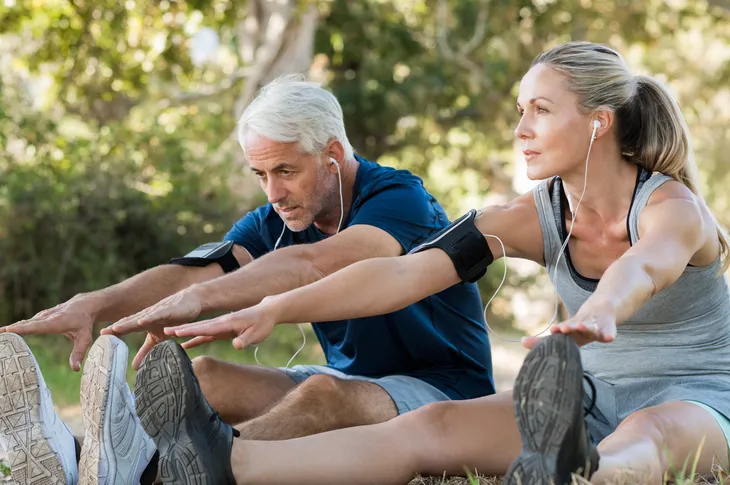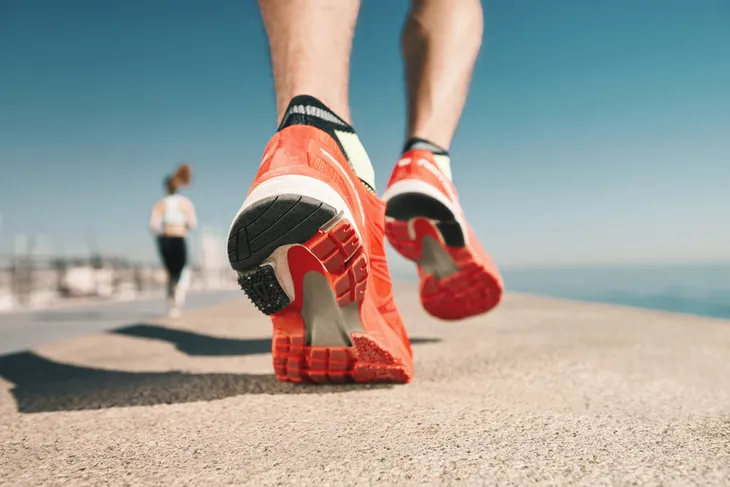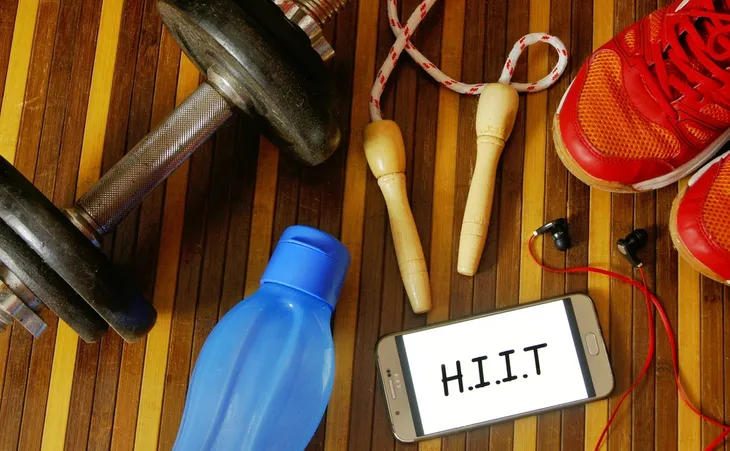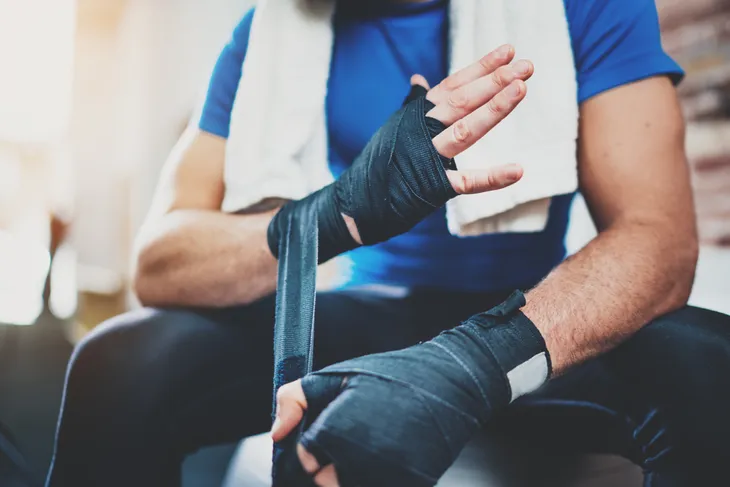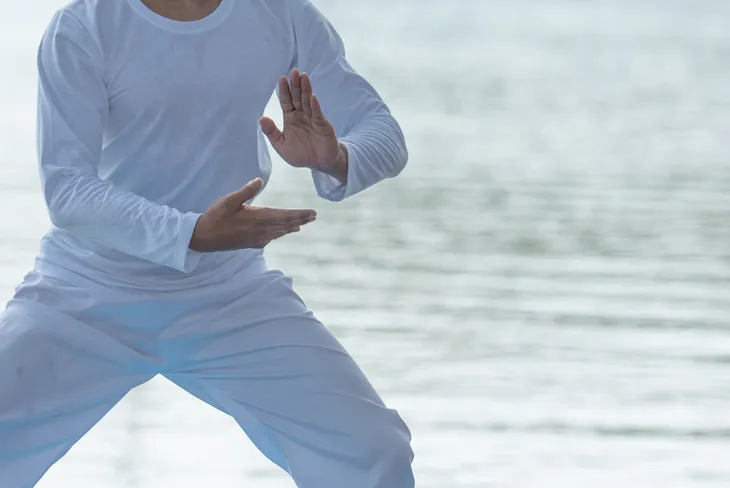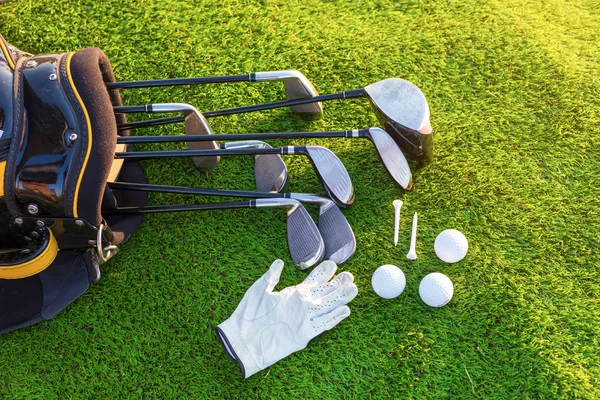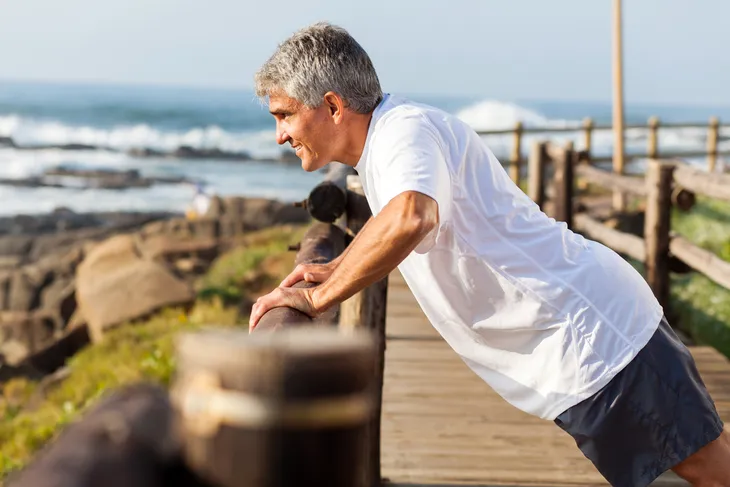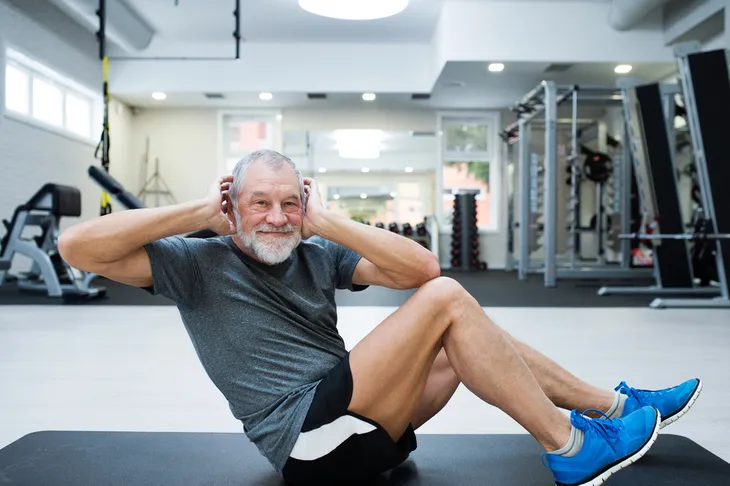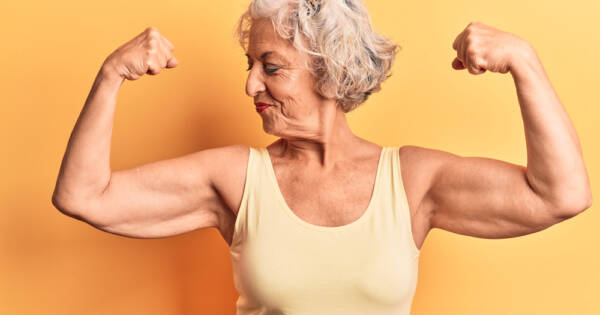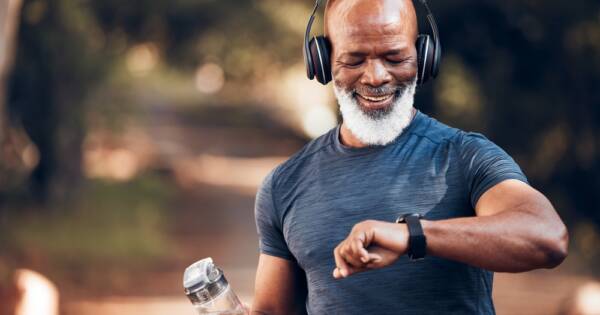While some people may think a man’s best fitness years are in their 20’s and 30’s, that’s not always true. Men in their 40’s and 50’s regularly say they feel the best they ever have from exercising regularly – but there may be some modifications for those over 50.
While you might not be breaking any records doing the 100-meter dash or winning ultra marathons when you’re 56, you can still achieve a high level of fitness that benefits your body and mind to help you age successfully. Here are 13 of the best exercise tips to keep in mind if you’re a man older than 50…
Resistance is Not Futile
LiveStrong says that resistance training – two or three times per week – is beneficial for men older than 50. In short, resistance training involves using weights to focus on muscle and strength development.
Examples of resistance training exercises given by the source include the bench press, squats or leg presses, “which work the larger muscle groups.” It recommends starting with weights that are lighter, with 15 to 20-repetitions. As you increase weight, you can drop the reps to 12 to 15, it adds. “Increased muscle mass will help elevate your metabolism and improve your body’s ability to burn fat,” it adds.
Walk It Off
Yes, getting an effective workout can be as simple as getting off the couch to go for a walk. Livestrong says “brisk walking” falls under cardiovascular exercises, which can benefit the performance of your lungs and heart.
It suggests starting with a brisk walk 3 to 4-times per week if you haven’t otherwise been active. If you can’t get outside for whatever reason (perhaps it’s too hot or cold), then you can turn to a treadmill or a stationary bike, it adds.
Getting Right To The Core
The same source says core exercises can be especially beneficial for men over 50. These exercises are aimed at strengthening the abdomen as well as the lower back, and includes planks and crunches, it adds.
It says you should try 3-sets of crunches (to the best of your ability) 3-times per week to tighten your stomach muscles, while planks (laying on your stomach and raising yourself using your forearms and toes while keeping your back straight) will strengthen both your stomach and your lower back muscles. For this exercise, “Contract your stomach muscles and breathe normally,” while holding the pose for a 20-count, it adds. Take a break and then repeat 3 to 6-times.
Stretch Your Routine
When you think of exercises, you’re probably fantasizing about bench pressing 200-pounds while running 20-miles. While that’s certainly not impossible for older adults, you can’t forget the importance of stretching to maintain muscle and joint mobility as you age.
EveryDay Health outlines stretches for the lower and upper body. For the lower half, grab on to a chair with one hand for balance and grab your foot with your other hand to stretch out your quadriceps, it offers. Hold this stretch for about 30-seconds. For the upper body, stand with your feet shoulder-width apart, and then bring both hands together behind your back. Pull your shoulders back and hold for 30-seconds to help stretch your arms and chest, it adds.
Pick Up The Pace
Aside from brisk walking, there are other aerobic exercises that can help you burn calories while lowering blood pressure, cholesterol, and joint health, explains EveryDay Health.
It says brisk walking is one option, but you can also try playing tennis, swimming, as well as more intense options such as hiking and running. Begin with 5-minute sessions for 3-days a week to get your heart pumping, and gradually work your way up to 30-minute sessions almost every day (give yourself a break once in a while), it suggests.
HIIT It Harder
High intensity interval training – or HIIT – is getting a lot of ink lately, and for good reason. The AARP touts it as an effective way to keep fitness levels up in older adults, and it can also be fun as it can provide different exercises during each routine.
The idea of HIIT is “briefly pushing your body to the max, then letting it recover, and then pushing it again,” it notes. While this type of exercise can benefit cardiovascular and respiratory health, it also cites a study that was published in Cell Metabolism that found interval training can slow signs of aging within cells. The study showed HIIT has the most benefit for 65-and older participants during the 12-week period, with a 69-percent increase for their cells to absorb oxygen and produce energy.
Get Your Kicks
What’s better than pretending you’re a martial arts master while also getting a great workout? Kickboxing can offer both of those benefits, and can burn up to 450-calories in a 50-minute session, according to Livestrong.
A typical kickboxing session involves repetitive kicking and punching that engages your entire body, “toning your core and abdominal muscles and melting away belly fat,” it adds. As well as boosting your cardiovascular health, it can also help increase your overall endurance, says the source.
Be More Flexible
A site called Care2.com actually lists seven reasons why Tai chi in particular is beneficial for those over 50. It’s actually a martial art, but not the kind you’d usually associate with self-defense. However, the site says it can help prevent falls, build strength, increase cardiovascular health, boost flexibility, and more.
It also says that unlike learning kung fu or karate, anyone can pick up Tai chi as it’s less taxing on your joints. Even those that are in a wheelchair can practice sitting Tai chi, it adds. The site even links to a video for beginners, but suggests getting training from a qualified instructor.
Add Water
Zoomer magazine goes as far as to say “swimming might just be the best exercise ever,” and backs it up with eight health benefits – as well as citing a study from the Indiana University Bloomington’s Counsilman Center for the Science of Swimming that says those who swim 3,200-meters (about 10,500-feet) or more 3 to 5-times a week “postponed the aging process.”
While that distance and duration may be a bit out of reach for some, “you don’t have to be a Masters Swimmer to benefit from swimming. Far from it,” offers the source. Even a “minimal” amount of swimming can have health benefits, it adds. Swimming is also a low-impact way to boost flexibility, lose weight, and improve mood, and it’s suitable for all ages, it explains.
Have a Swinging Good Time
Before you get the wrong idea, what we’re talking about is playing golf. ExerciseRight.com explains that going 18-holes “may not be the fastest route to fitness,” but playing this sport regularly may actually extend your life.
The source cites data from the Karolinska Institutet, a Swedish medical university, that shows the mortality rate for golfers is 40-percent lower than for people of the same gender, age, and socioeconomic status. Swinging a golf club can add 5-years to your life expectancy, it adds.
Push Yourself Up
The same source says that the basic push-up is “the ultimate barometer of fitness, especially in middle age.” The source notes a push-up, done properly, engages all muscle groups including arms, chest, abdomen, and legs.
What’s perhaps more important for older adults is that regularly doing push-ups – which don’t require any special equipment or gym memberships – can help you build the required strength to reach out and prevent a fall, which can reduce the risk of fractures, it adds.
Shake It Up
Men’s Health magazine says that one of the best things you can do for yourself is learn new skills to challenge your body and mind. Doing the same routines day in and day out can actually be harmful, it adds. “Challenging your body in the same ways day after day for decades is an efficient way to chew up your body,” it notes. “Challenging it in different ways is the perfect cure.”
The site says it can be intimidating because trying something new might mean you’re not very good at it at first. However, it’s a satisfying feeling to stay at it and improve over time, it adds. You may want to talk to a qualified trainer to help switch things up with routines that are age and fitness level appropriate.
Exercise Caution
Remember, as much as exercise is an important component of your overall health, don’t forget that your body won’t necessarily bounce back as quickly as it did when you were 20, warns LiveStrong.
With that in mind, try to start your exercise regime “gently” and increase the workload when your fitness level increases. You should also give your body a chance to rest and recover between sessions, it adds. It’s wise to consult a physician before you embark on a new exercise program, it notes.




